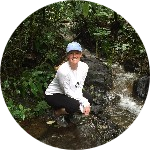About This Project
There is increasing evidence that microscopic plastics persist in the environment, accumulate hazardous chemicals, and adversely affect marine organisms that ingest them. This project will examine microscopic plastic transportation, fate and dynamics in Winyah Bay, South Carolina to provide valuable information to protected areas on potential ecosystem damage.
Ask the Scientists
Join The DiscussionWhat is the context of this research?
Microplastics are plastic fragments that are less than or equal to 5mm in size and are created from the physical degradation of macroplastic debris (i.e., plastic bottles, fishing line, plastic bags, etc.) or through manufacture for personal care, cosmetics, and air blast cleaning products. There is increasing evidence that microplastics adversely affect marine organisms, including seabirds, blue mussels, fish and crustaceans. Ingestion of microplastics and the chemicals they carry may lead to endocrine disruption which may affect mobility, reproduction, development, and carcinogenesis. The goal of this project is to shed light on the fate, transport, and dynamics of continental microplastic inputs into marine environments as this knowledge is currently very limited.
What is the significance of this project?
Microplastics have been recorded in many different types of ecosystems worldwide, including even remote and protected aquatic environments. Winyah Bay and the rivers that empty into it are relatively protected and provide unique coastal habitats for wildlife. However, this area is still prone to microplastic invasion. 47,060 square kilometers of partially populated land drains into it, boating traffic uses the major Atlantic Intracoastal Waterway as a connector through the bay, and it is frequented by many fishermen and tourists.
What are the goals of the project?
The outcome of this project will include microplastic data (i.e., abundance, plastic type, color, and size) in Winyah Bay, SC, a validated hydrodynamic model that can simulate the fate and transport of microplastics, and a statistical risk assessment tool for microplastics in the Winyah Bay area. This will provide valuable information to protected areas on potential damage to marine organisms and ecosystems, and also possible sources as to where these plastics originate. The project will begin July 2016 with a preliminary study and end summer of 2017. We will share updates on our findings and videos of our computer model's prediction on plastic transportation.
Budget
Your contribution will be dedicated to funding our boat expenses. Coastal's pontoon research vessel is priced at $300/day and is needed for 9 days of sampling to meet this project's goal. This totals to $2,700 in boat expenses. Funds raised through this website will provide most of the funding for boat expenses ($2,400). We are hopeful to be funded in April/May 2016 by Coastal's Graduate Student Incentive Grant and the M.K. Pentecost Ecology Fund. If funded, these two sources will be mostly dedicated to field and lab equipment expenses while also covering any remaining boat expenses ($300).
Endorsed by
Meet the Team
Samantha Ladewig
I love traveling and seeing worlds outside of my own. Along my traveled paths, I've developed a passion for learning about the world's various landscapes and cultures. What strikes me the most is seeing beautiful, pristine areas trashed with litter. With my Bachelor's of Science background in Biology and recent studies in Marine Science at CCU I plan to tackle the main question: Where is the litter coming from?
The most harmful litter in my opinion are microplastics. I believe this because they directly affect microorganisms at the start of the food chain whom all are crucial to aquatic ecosystems. Eventually, through biomagnification, microplastics and the chemicals they transport with them will work their way back to the top of the food chain.... getting back to us humans in our food!
I am well versed in proper laboratory usage and performance from my many lab courses in undergrad at Concordia University Texas and also my involvement with my CCU research group's previous work on microplastics. My field sampling skills and knowledge have been enhanced as I have volunteered many hours towards helping other graduate students at CCU obtain their field data over the past two years.
Project Backers
- 30Backers
- 111%Funded
- $2,687Total Donations
- $89.57Average Donation

